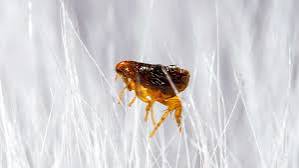
Ways to Prevent Fleas in Your Home: Fleas are tiny, persistent, and incredibly frustrating. These blood-sucking parasites don’t just make your pets itchy and uncomfortable they can quickly turn your home into a breeding ground for infestation. Even a single flea can lay hundreds of eggs, leading to full-blown outbreaks that are tough to eliminate.

The best strategy is prevention. By taking proactive steps to keep fleas at bay, you save yourself and your pets from weeks of scratching, cleaning, and chemical warfare. In this guide, we’ll walk through five effective, practical methods to prevent fleas from ever taking hold in your home.
5 Ways to Prevent Fleas in Your Home
1. Maintain Year-Round Flea Protection for Pets
Your pets are often the primary way fleas enter your home. So, your first line of defense is keeping your dogs and cats protected at all times not just in summer.
Use Vet-Recommended Flea Treatments:
- Topical treatments: Applied to the skin (e.g., Frontline Plus, Advantage II)
- Oral medications: Monthly pills that kill fleas before they reproduce (e.g., NexGard, Bravecto)
- Flea collars: Like Seresto, which release slow-acting flea repellents
Pro Tip: Always consult your veterinarian for the best product based on your pet’s weight, age, and health.
Don’t Skip Winter Months
Fleas can survive indoors year-round. Indoor heating creates a perfect breeding environment, so consistent treatment is essential even when it’s cold outside.
2. Vacuum Frequently and Thoroughly
Vacuuming is one of the most effective ways to physically remove fleas, larvae, and eggs—especially from carpets and furniture.
Target These Areas:
- Carpets and rugs: Especially under furniture, beds, and pet areas
- Upholstered furniture: Use attachments to get into creases and corners
- Pet beds and play areas: Vacuum around and under pet furniture
Tip: Empty the vacuum canister outside immediately after cleaning. Bagged vacuums should have the bag sealed in a plastic bag before disposal.
How Often to Vacuum:
- Weekly for general maintenance
- Daily during flea season or outbreaks
3. Wash Pet Bedding and Household Fabrics Regularly
Soft furnishings and fabrics trap flea eggs and larvae. Frequent washing helps break their life cycle.
Wash These Weekly (or More Often if Infested):
- Pet beds
- Throw blankets
- Pillow covers and slipcovers
- Curtains near pet lounging zones
Use hot water (above 120°F) and high-heat drying to kill all stages of fleas.
Bonus Tip: Consider rotating pet bedding to allow one set to be cleaned while the other is in use.
4. Treat Your Home with Pet-Safe Insect Control
Chemical and natural treatments can help prevent and control flea infestations, especially in hidden or hard-to-clean spots.
Indoor Treatment Options:
- Insect Growth Regulators (IGRs): Like methoprene or pyriproxyfen, which prevent flea eggs from maturing
- Pet-safe sprays: Choose products labeled for indoor use and safe around animals (e.g., Vet’s Best Flea and Tick Spray)
- Diatomaceous Earth: A natural powder that dehydrates fleas on contact. Sprinkle on carpets and vacuum after a few hours.
Caution: Always read labels and avoid overuse—some products can irritate pets or trigger allergies. Keep pets out of treated areas until fully dry.
READ ALSO: Are Harnesses or Collars Better for Walking Dogs?
5. Maintain an Outdoor Flea Barrier
Fleas can also live in shaded areas outside—then hitchhike indoors via your pets or even your shoes.
Outdoor Prevention Tips:
- Mow the lawn regularly: Fleas love shady, humid environments
- Remove organic debris: Like leaf piles and overgrown plants
- Treat yards with flea granules or sprays: Use pet-safe options like Wondercide or nematode-based flea killers
- Limit wildlife: Raccoons, squirrels, and feral cats can bring fleas. Secure trash bins and block crawl spaces.
Create a Perimeter Zone: Treat a buffer zone around your home’s foundation to reduce the chance of flea entry.
Bonus: Preventive Grooming
Regular grooming helps you spot fleas early and prevent them from taking hold.
- Brush pets weekly (daily during flea season) with a flea comb
- Bathe pets monthly using flea-repelling shampoos
- Check ears, under legs, and base of tail for flea dirt (tiny black specks)
Flea Life Cycle: Why Prevention Works Best
Fleas have a four-stage life cycle: egg, larva, pupa, and adult. Adult fleas are only about 5% of the infestation; the rest are eggs and immature stages hiding in carpets, cracks, and fabrics.
Preventive methods target all stages, not just visible adult fleas. That’s why a multi-pronged approach is essential—no single method works alone.
FAQs
How do I know if my pet has fleas?
Common signs include:
- Excessive scratching or biting
- Red, irritated skin
- Flea dirt (tiny black specs) on fur
- Live fleas seen while grooming
Using a flea comb can help detect fleas at home.
Can fleas live on humans?
Fleas may bite humans but don’t live on us. However, humans can carry flea eggs or larvae into the home via clothing, shoes, or furniture.
How long do fleas live indoors?
Fleas can live up to 100 days indoors under ideal conditions. Eggs hatch in 2–5 days, and a full life cycle can complete in as little as 2–3 weeks.
Do I need to treat my house if I treat my pet?
Yes. If you only treat your pet, flea eggs and larvae in your home can still mature and reinfest your animal. Treat both simultaneously.
Are natural flea remedies effective?
Some, like diatomaceous earth, essential oils, and apple cider vinegar, can help—but they work best as part of a larger prevention plan, not as standalone solutions.
What’s the best vacuum for flea prevention?
Vacuums with strong suction and HEPA filters are ideal. Canister vacuums with disposable bags are especially hygienic for flea cleanup.
How long does it take to eliminate a flea infestation?
It may take 3–8 weeks to fully break the flea life cycle, depending on the extent of infestation and consistency of treatment.
Leave a Reply
You must be logged in to post a comment.